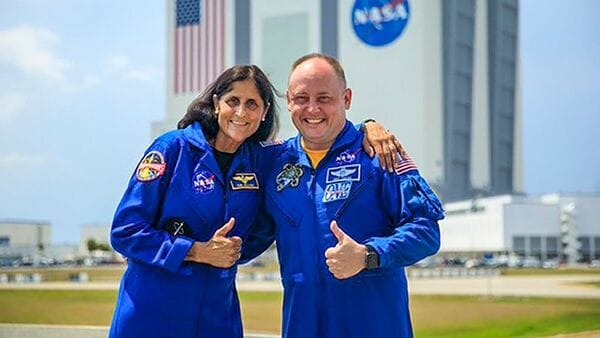Indian-origin astronaut Sunita Williams finds herself unexpectedly extending her stay on the International Space Station (ISS), as unforeseen glitches in the Boeing Starliner delay her return journey to Earth. Originally slated to return on June 26, the exact timing of her and crewmate Butch Wilmore’s return remains uncertain.
Table of Contents
Technical Issues Plague Starliner
The Boeing Starliner, which is on its inaugural mission, has been plagued by technical issues from the outset. The spacecraft’s launch had already been postponed twice due to a series of glitches, raising concerns about its reliability. These issues came to a head once the spacecraft was docked at the ISS, with multiple leaks and thruster malfunctions coming to light. According to a report by NDTV, the Starliner experienced five helium leaks and problems with five of its 28 thrusters, of which at least 14 are essential for a safe return to Earth.
NASA’s Response and Preparations
Despite these setbacks, NASA remains optimistic about resolving the issues. Steve Stich, manager of NASA’s commercial crew program, mentioned that while the spacecraft is docked to the ISS, engineers are using the extra time to ensure that all critical station activities are carried out smoothly and preparations for the astronauts’ safe return are completed. Stich emphasized that the Starliner was performing well while docked, providing an opportunity to address the malfunctions without the immediate pressure of re-entry.
Allegations of Negligence
On her third space trip, Sunita Williams had previously praised the Starliner as a “fantastic spacecraft.” However, this optimism is now overshadowed by growing allegations of negligence. Whistleblowers within NASA and Boeing allege that managers were aware of the Starliner’s technical faults but proceeded with the mission, deeming the issues too minor to justify further delays. These claims, brought forward by at least 20 whistleblowers, suggest a culture of overlooking safety concerns in favour of maintaining schedules.
Boeing’s Safety Record Under Scrutiny
This isn’t the first time Boeing has faced such accusations. Santiago Paredes, a former quality inspector at Spirit AeroSystems, a Boeing supplier, recently told the BBC that aircraft components often left the factory with serious defects. When he raised concerns, he was reportedly ridiculed for causing production delays. While Spirit AeroSystems has strongly denied these allegations, Boeing CEO David Calhoun defended the company’s safety record in a recent Congressional hearing, asserting their commitment to safety.
Fuel Constraints and Supply Assurance
The limited fuel supply for the astronauts’ return voyage adds to the urgency. According to Business Today, the Starliner has only 27 days of fuel remaining. However, NASA has assured that there is no immediate rush, citing ample supplies available on the ISS to support the astronauts while solutions are sought. This reassurance aims to mitigate concerns about the immediate well-being of Williams and Wilmore during this period of uncertainty.
Biological Threat on ISS
Compounding the technical challenges, the ISS is grappling with a new biological threat: Enterobacter bugandensis, a multi-drug-resistant bacteria. This superbug has thrived in the closed environment of the space station, posing a potential risk to the crew’s respiratory health. The emergence of such bacteria underscores the complex and often unpredictable nature of long-term space habitation.
Financial and Operational Stakes
The Boeing Starliner mission, under a $4.2 billion contract, has already cost the company approximately $5.7 million, reflecting the significant investment and high stakes involved. The spacecraft’s performance is crucial not only for Boeing’s reputation but also for the broader commercial spaceflight sector.
Importance of the ISS
The ISS, often described as a “mini-city in space” due to its size and complexity, is vital in international space research. Astronauts from various space agencies, including NASA, use the station for a wide range of scientific experiments and technology demonstrations that are impossible to conduct on Earth. The current predicament of Williams and her crewmate highlights the inherent risks and challenges of human spaceflight, especially when pioneering new technology.
Resilience and Future Lessons
In the face of these challenges, the resilience and professionalism of the astronauts and their ground support teams are crucial. While the delays and technical issues have undoubtedly tested the capabilities of the Starliner and its mission team, they also provide valuable lessons for future space missions. Ensuring the safety and success of such missions remains a top priority for all involved, as space agencies and private companies continue to push the boundaries of human space exploration.
As NASA and Boeing work tirelessly to resolve the Starliner’s issues, the world watches with bated breath. The safe return of Sunita Williams and Butch Wilmore will not only mark a significant milestone for the Starliner program but also reinforce the importance of safety and meticulous planning in the ambitious realm of space travel.
